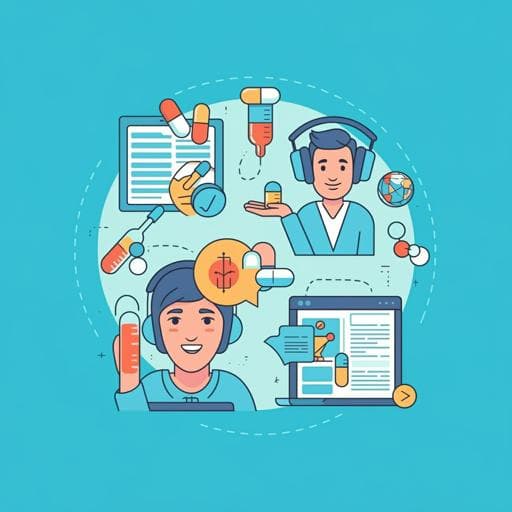
Medicine and Health
Teaching resources for the European Open Platform for Prescribing Education (EurOP²E)—a nominal group technique study
M. J. Bakkum, B. J. Loobeek, et al.
Discover essential online teaching resources for prescribing education identified by 20 educators from 15 European countries. This study highlights the demand for prescribing scenarios, engaging gamification, and repositories for exam questions. Join the research team, including Michiel J. Bakkum, Bryan J. Loobeek, and Paraskevi Papaioannidou, in shaping the future of pharmacotherapy education.
~3 min • Beginner • English
Introduction
Final-year medical students and junior doctors across Europe report insufficient preparation for safe, effective, and responsible prescribing, reflected in poor performance on case-based prescribing exams and high rates of prescribing errors. Problem-based CPT education improves preparedness, yet many European universities still rely on traditional methods and face challenges transitioning to problem-based approaches. The EACPT Education Working Group issued recommendations to improve and harmonize CPT education, including greater use and sharing of online resources. The COVID-19 pandemic accelerated the shift to virtual teaching, underscoring the need for high-quality online, reusable, problem-based materials. This study aimed to identify and prioritize the types of online problem-based teaching resources that international CPT teachers would like to find on the EurOP²E platform to sustain and enhance prescribing education during and beyond the pandemic.
Literature Review
While no dedicated literature review section is provided, the introduction and discussion reference prior evidence: (1) widespread lack of preparedness for prescribing among European medical trainees; (2) superiority of problem-based over traditional teaching for prescribing skills; (3) existing EACPT recommendations advocating online resource use and sharing; and (4) prior overviews indicating many digital resources exist but are siloed locally and rarely shared. The discussion compares current findings with earlier key learning outcomes for CPT, highlighting new emphasis on deprescribing, overprescribing, and planetary health.
Methodology
Design: Nominal Group Technique (NGT) study complemented by thematic analysis. Rationale: NGT enables equitable idea generation, detailed discussion, and independent anonymous prioritization, minimizing dominance by vocal participants and producing a prioritized list; thematic analysis provides conceptual synthesis across groups.
Participants and sampling: Members of the Network of Teachers in Pharmacotherapy education (NOTIP) across EU, UK, Norway, and Serbia. Purposive sampling of 39 invitees (1–2 per country) based on involvement in teaching innovation/prior research. Invitees could forward invitations. Two reminders process included one follow-up after two weeks.
Data collection: Four online meetings in October 2021 via Microsoft Teams, groups of 4–6 participants, lasting 85–110 minutes. Three researchers attended each meeting (host, technical support/voting setup, observer/timekeeper). Sessions recorded (audio/video). NGT phases: (1) 5 minutes silent idea generation; (2) round‑robin idea presentation; (3) group discussion to clarify/combine/alter ideas; (4) anonymous voting for top five ideas using Mentimeter multi‑voting. Scoring: first choice 5 points to fifth choice 1 point; overall ranking computed; ties resolved by number of voters. Ideas captured in real time on Google Jamboard.
Data analysis: Ranking results expressed as average score per participant and ranked accordingly. Meetings transcribed verbatim. Thematic analysis conducted by two researchers (iterative reading, code development, coding in MAXQDA Standard 2020), themes reviewed independently and finalized with a third researcher. Member checking performed: six authors who participated verified internal validity; five other CPT teacher authors provided external validation. Reporting followed COREQ guidelines. Reflexivity: research team backgrounds in CPT education and a constructivist stance informed interpretation, referencing WHO Guide to Good Prescribing and EurOP²E framework.
Key Findings
- Participation: 20 CPT teachers from 20 institutions in 15 European countries participated across four meetings (data saturation by meeting four). Meetings lasted 85–110 minutes. Across sessions, 35 teaching materials were proposed and ranked.
- Thematic synthesis: Ten themes emerged, grouped into three overarching domains.
1) Learning outcomes for CPT (priority order within overall list):
• Prescribing scenarios (Priority 1): Emphasis on essential drugs and common diseases, aligned to student level (from single to multimorbidity), including medication review, deprescribing, pharmacogenomics, drug allergies, rapidly evolving areas (e.g., biologics), integration of diagnostic and therapeutic reasoning, use of real-life clinical data, and adaptive/longitudinal cases. Modalities: pre‑recorded consultations, role‑play, live online case discussions, interactive gamified virtual patients.
• Knowledge materials (Priority 7): Short multimedia clips/podcasts on cross‑country common CPT denominators (e.g., special populations, renal dosing, deprescribing), mechanism‑focused videos; suited for flipped classroom.
• Topical issues—“not in textbook stuff” (Priority 8): Antimicrobial resistance, opioid crisis, sustainable/planetary health, inequality, pharma industry interactions, drug development/regulation, and ethics.
• Personalized and evidence‑based medicine (Priority 9): Teaching nuance between guideline evidence and individualized care (e.g., when not to apply guidelines), understanding reimbursement/affordability, appraising literature in low/no‑evidence contexts.
• Formularies (Priority 10): European reference list of essential medicines for students (200–300 drugs) with tools to create personalized formularies; leverage existing P‑drugs apps/websites for translation and adoption.
2) Format of teaching:
• Interactivity and gamification (Priority 2): Interactive virtual patients simulating realistic responses and time‑pressured scenarios; escape‑room style cases; in‑class competitive quizzes; DDI rehearsal games.
• Online transdisciplinary, transnational case discussions (Priority 4): Real/simulated cases discussed live by students from different health professions and countries, student‑led, recorded for reuse, addressing ethical/planetary health topics and acknowledging multiple valid solutions.
• Decision support systems (Priority 5): Training in electronic prescribing systems (“the scribing bit”), realistic decision support alerts, sandbox EHR environments adaptable to local systems; standalone tools for polypharmacy/interaction checking, pregnancy/lactation safety, and ADR identification.
3) Resource and faculty development:
• Repository of exam questions and reusable materials (Priority 3): Collect knowledge and case‑based exam questions with rubrics, slides, videos, figures, and curated further‑reading links for advanced learners.
• Teaching the teacher (Priority 6): International teach‑the‑teacher courses on problem‑based learning and updates in CPT education; platform functions as hub for innovations and peer support (forum/discussion board); addresses scarcity of trained CPT teachers and change resistance.
- Notable trend: New/heightened interest in deprescribing, overprescribing, non‑pharmacological interventions, and the planetary health impact of prescribing.
Discussion
The study directly addresses the need to identify and prioritize online problem‑based resources to support and harmonize CPT education across Europe, particularly in the context of the COVID‑19 driven shift to virtual formats. By engaging educators from 15 countries, it produced a consensus‑driven, prioritized roadmap highlighting prescribing scenarios, interactive/gamified learning, reusable assessment repositories, live interprofessional case discussions, and decision support tools, alongside faculty development and formulary strategies. These findings align with and operationalize EACPT recommendations to expand online resource use and sharing, and they expose current fragmentation and limited collaboration—many suitable resources exist locally but are not openly shared. The thematic emphasis on planetary health, deprescribing, and context‑based/personalized decision‑making expands previously defined CPT learning outcomes, signaling evolving priorities in prescribing education. Implementing these priorities through EurOP²E—both by curating/sharing existing assets and co‑creating adaptable, internationally relevant materials—can improve access, foster collaboration, and enhance students’ preparedness for safe, effective, and responsible prescribing.
Conclusion
European CPT educators prioritized a set of online, problem‑based resources spanning: (1) learning outcomes (prescribing scenarios; knowledge multimedia; topical ethical and societal issues; personalized/evidence‑based medicine; formularies), (2) teaching formats (interactivity/gamification; transdisciplinary international case discussions; decision support tools), and (3) resource/faculty development (repositories of exam questions and reusable materials; teach‑the‑teacher initiatives). EurOP²E should act as facilitator and catalyst—supporting communication, collaboration, and faculty development—while also curating and initiating co‑creation of adaptable, ready‑to‑use materials. The planetary health impact of prescribing emerges as a new, important learning outcome for CPT education. Future work will focus on collaboratively producing and openly sharing these prioritized resources.
Limitations
- Sampling and representation: Approximately half of invited participants did not respond; participants from some larger EU member states (e.g., France, Portugal, Hungary) were not included, potentially limiting geographical representation. Nonetheless, data saturation was achieved across four meetings.
- Time constraints: Meetings were limited to ~90 minutes; in three of four meetings, phase 2 (idea generation) was curtailed and phase 3 slightly rushed. Mitigation included allowing final additions of crucial ideas and continuing until no new suggestions emerged.
- Priming and novelty: Some suggestions were not entirely new and may have been influenced by participants’ involvement in related studies (e.g., a Delphi on essential medicines), potentially biasing theme emergence.
Related Publications
Explore these studies to deepen your understanding of the subject.







